MAD (1952-2018) #1
Xerox Cover: 0.2
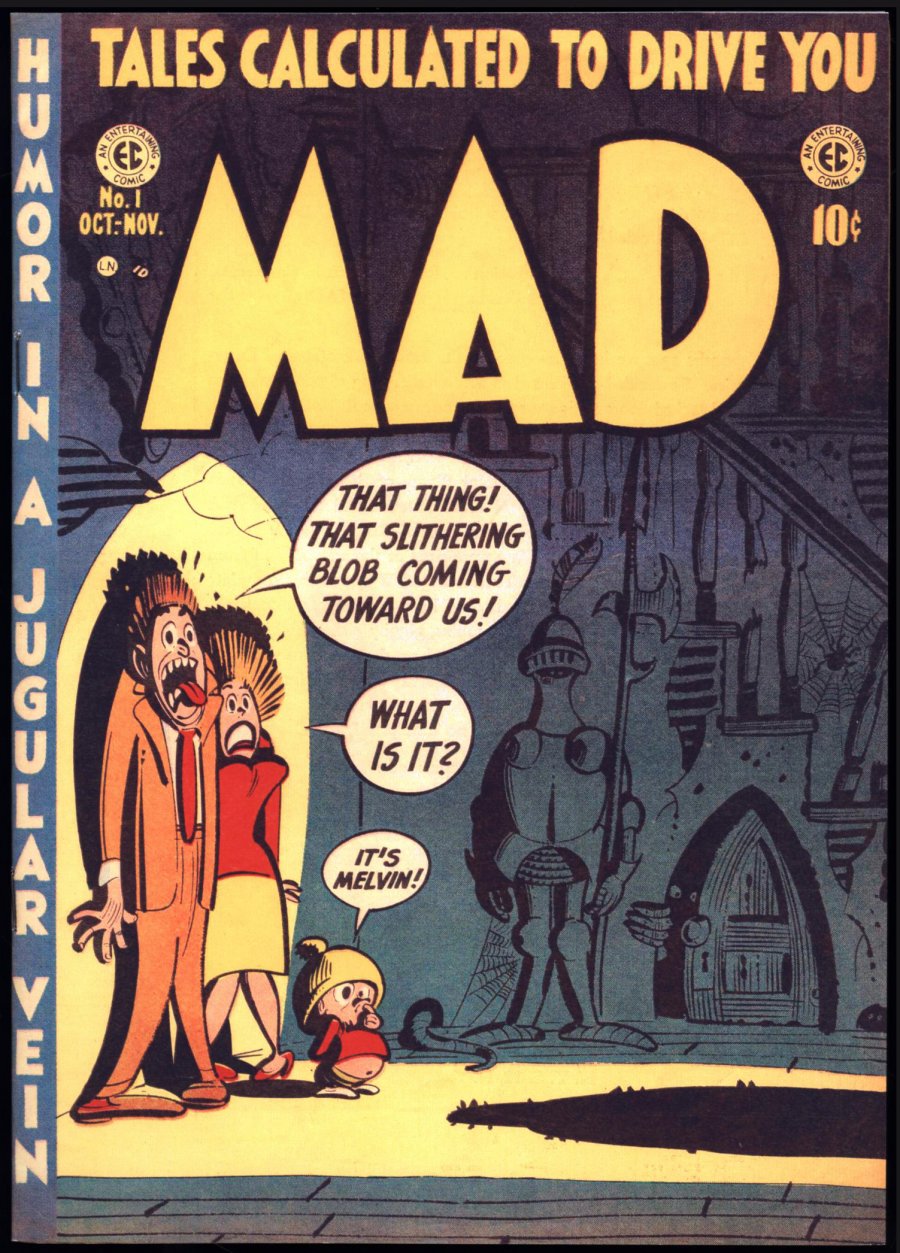
(Stock Image)

YES
Accepting Offers
--
Offers
PUBLISHER: EC
COMMENTS: a very nice coverless copy with a xerox cover
historic 1st issue!; Kurtzman cvr; Wood, Davis art (10-11/52) COMIC BOOK IMPACT rating of 9 (CBI)
Read Description ▼
historic 1st issue!; Kurtzman cvr; Wood, Davis art (10-11/52) COMIC BOOK IMPACT rating of 9 (CBI)
DESCRIPTION
a very nice coverless copy with a xerox cover
historic 1st issue!; Kurtzman cvr; Wood, Davis art (10-11/52) COMIC BOOK IMPACT rating of 9 (CBI)
The argument can be made -- and has been made very well -- that American comedy of the past five decades owes its existence and style largely to this unassuming little raised-middle-finger of a comic, William Gaines' brutal, brilliant, brave broadside directed squarely at the heart of post-war American culture. It was a nearly instant smash hit, inspiring dozens of often dreadful imitators, and eventually morphed into a black and white magazine that became even more influential and world-famous throughout the 1960s and 1970s, but it was this full-color blast of sick humor that was a nuclear explosion going off in the minds of impressionable young readers and hip comedy mavens. One of the rare instances in which a series' style and tone was dead-on from the very first page, this outlandish first issue allowed Gaines and Kurtzman's small army of incredible talents to unleash the pent-up frustrations and residual traumas felt by the generation that grew up in the grinding poverty of the depression and survived the unspeakable horrors of WWII. The result influenced everyone from Lenny Bruce to George Carlin to Ernie Kovacs to the Smothers Brothers, and beyond. It's hard to overstate the importance of this first issue, and the 22 comic issues following, to American popular culture, so we'll just stop trying now.
Artists Information
Will Elder is an American Cartoonist and comic book artist who was part of the team that made up Harvey studios. Will's art style described as wacky panels with humorous details on top of humor. Elder's most notable works include Mad, Little Annie Fanny and Humbug.
Wally Wood is an American comic book artist/ writer who is also one of the founding artist for Mad comics. In addition to penciling numerous comic book pages, Wally also ventured into product illustration, music album covers, and trading cards. Wally's most notable works include the aforementioned Mad comics, Marvel's Daredevil, and Weird-Science Fantasy for EC comics.
Harvey Kurtzman was an American cartoonist and editor. His best-known work includes writing and editing the parodic comic book Mad from 1952 until 1956, and illustrating the Little Annie Fanny strips in Playboy from 1962 until 1988.
John Burton Davis, Jr. was an American cartoonist and illustrator, known for his advertising art, magazine covers, film posters, record album art and numerous comic book stories. He was one of the founding cartoonists for Mad in 1952.
John Powers Severin was an American comics artist noted for his distinctive work with EC Comics, primarily on the war comics Two-Fisted Tales and Frontline Combat; for Marvel Comics, especially its war and Western comics; and for his 45-year stint with the satiric magazine Cracked. He was one of the founding cartoonists of Mad in 1952. Severin was inducted into the Will Eisner Award Hall of Fame in 2003.
historic 1st issue!; Kurtzman cvr; Wood, Davis art (10-11/52) COMIC BOOK IMPACT rating of 9 (CBI)
The argument can be made -- and has been made very well -- that American comedy of the past five decades owes its existence and style largely to this unassuming little raised-middle-finger of a comic, William Gaines' brutal, brilliant, brave broadside directed squarely at the heart of post-war American culture. It was a nearly instant smash hit, inspiring dozens of often dreadful imitators, and eventually morphed into a black and white magazine that became even more influential and world-famous throughout the 1960s and 1970s, but it was this full-color blast of sick humor that was a nuclear explosion going off in the minds of impressionable young readers and hip comedy mavens. One of the rare instances in which a series' style and tone was dead-on from the very first page, this outlandish first issue allowed Gaines and Kurtzman's small army of incredible talents to unleash the pent-up frustrations and residual traumas felt by the generation that grew up in the grinding poverty of the depression and survived the unspeakable horrors of WWII. The result influenced everyone from Lenny Bruce to George Carlin to Ernie Kovacs to the Smothers Brothers, and beyond. It's hard to overstate the importance of this first issue, and the 22 comic issues following, to American popular culture, so we'll just stop trying now.
Artists Information
Will Elder is an American Cartoonist and comic book artist who was part of the team that made up Harvey studios. Will's art style described as wacky panels with humorous details on top of humor. Elder's most notable works include Mad, Little Annie Fanny and Humbug.
Wally Wood is an American comic book artist/ writer who is also one of the founding artist for Mad comics. In addition to penciling numerous comic book pages, Wally also ventured into product illustration, music album covers, and trading cards. Wally's most notable works include the aforementioned Mad comics, Marvel's Daredevil, and Weird-Science Fantasy for EC comics.
Harvey Kurtzman was an American cartoonist and editor. His best-known work includes writing and editing the parodic comic book Mad from 1952 until 1956, and illustrating the Little Annie Fanny strips in Playboy from 1962 until 1988.
John Burton Davis, Jr. was an American cartoonist and illustrator, known for his advertising art, magazine covers, film posters, record album art and numerous comic book stories. He was one of the founding cartoonists for Mad in 1952.
John Powers Severin was an American comics artist noted for his distinctive work with EC Comics, primarily on the war comics Two-Fisted Tales and Frontline Combat; for Marvel Comics, especially its war and Western comics; and for his 45-year stint with the satiric magazine Cracked. He was one of the founding cartoonists of Mad in 1952. Severin was inducted into the Will Eisner Award Hall of Fame in 2003.

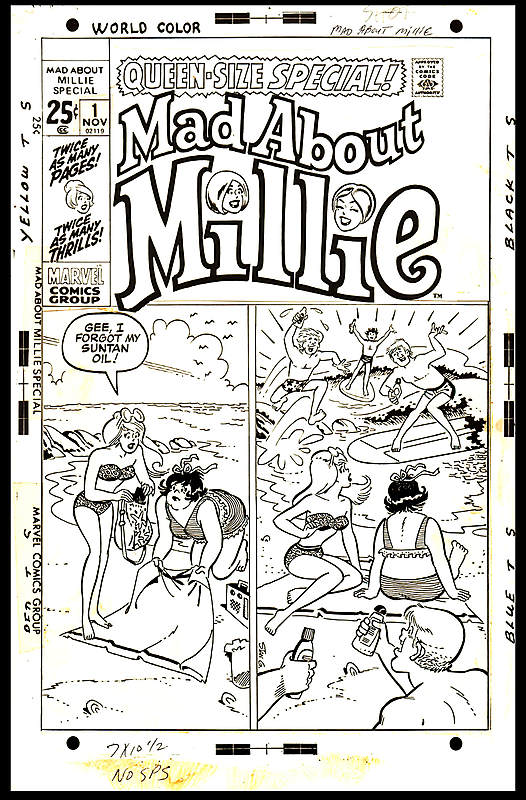
Goldberg, Stan - MAD ABOUT MILLIE ANNUAL (1971) #1 Cover
Marvel VF: 8.0
Stan Goldberg pencils & inks, signed Stan G.; image size 10" x 15"
Stan Goldberg pencils & inks, signed Stan G.; image size 10" x 15"

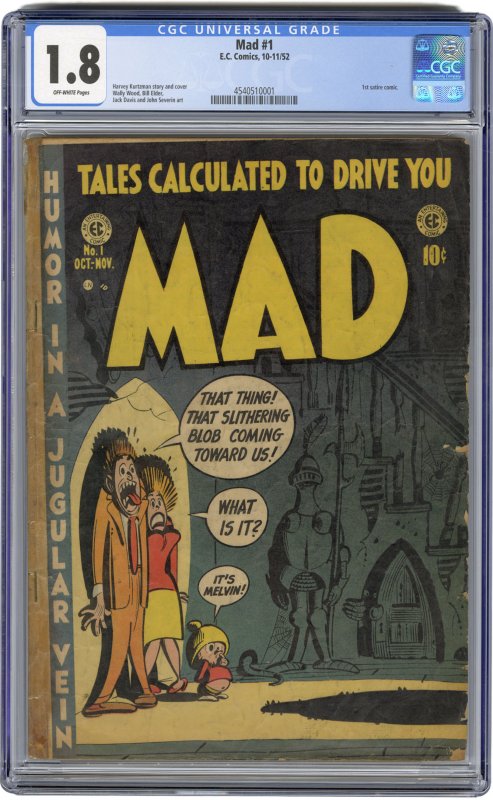
MAD (1952-2018) #1
EC CGC G-: 1.8
ow pages
historic 1st issue!; Kurtzman cvr; Wood, Davis art (10-11/52) COMIC BOOK IMPACT rating of 9 (CBI)
historic 1st issue!; Kurtzman cvr; Wood, Davis art (10-11/52) COMIC BOOK IMPACT rating of 9 (CBI)
ow pages
historic 1st issue!; Kurtzman cvr; Wood, Davis art (10-11/52) COMIC BOOK IMPACT rating of 9 (CBI)
historic 1st issue!; Kurtzman cvr; Wood, Davis art (10-11/52) COMIC BOOK IMPACT rating of 9 (CBI)

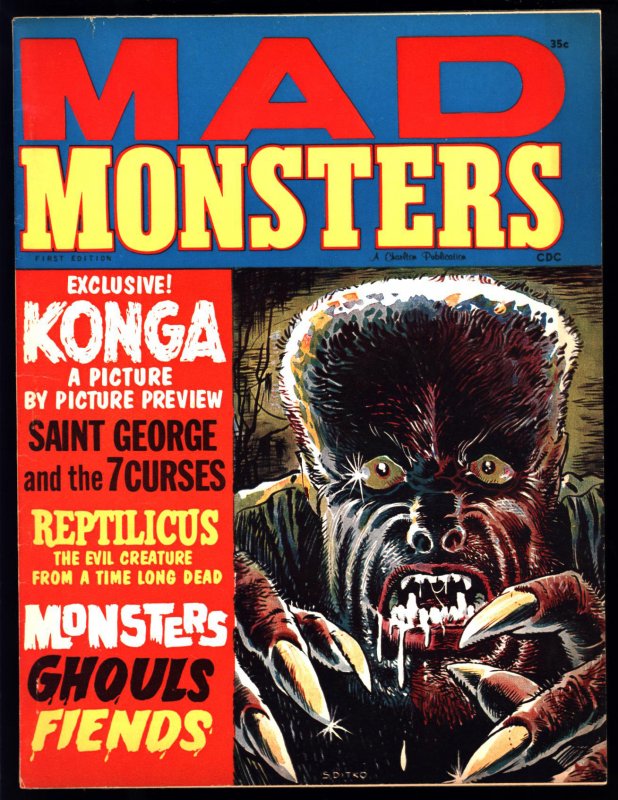
MAD MONSTERS (1961-64) #1
Charlton VF-: 7.5
1961 monster mag. DITKO WOLFMAN COVER
1961 monster mag. DITKO WOLFMAN COVER


MAD MONSTERS (1961-64) #1
Charlton VG+: 4.5
1961 monster mag. DITKO WOLFMAN COVER
1961 monster mag. DITKO WOLFMAN COVER

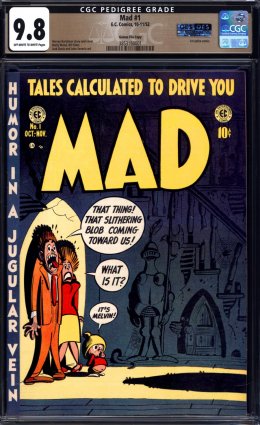




historic 1st issue!; Kurtzman cvr; Wood, Davis art (10-11/52) COMIC BOOK IMPACT rating of 9 (CBI)
Gaines File Copy
historic 1st issue!; Kurtzman cvr; Wood, Davis art (10-11/52) COMIC BOOK IMPACT rating of 9 (CBI)
Gaines File Copy